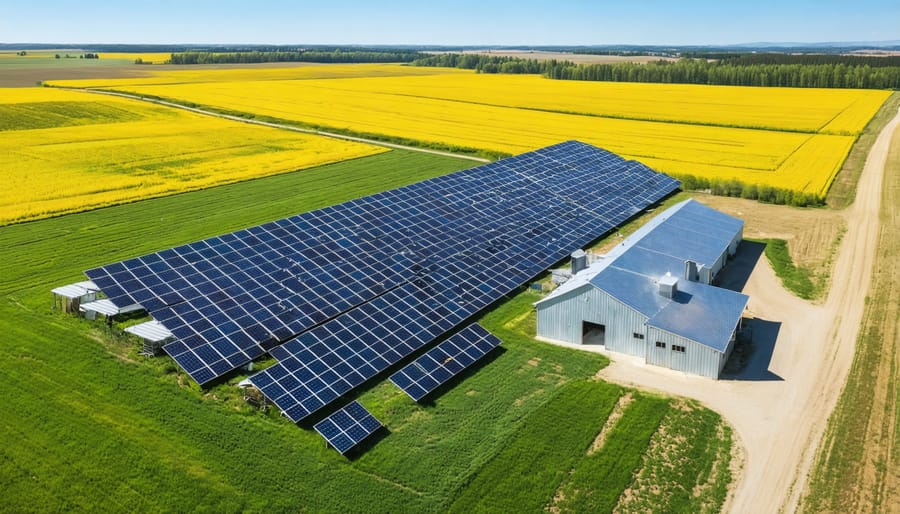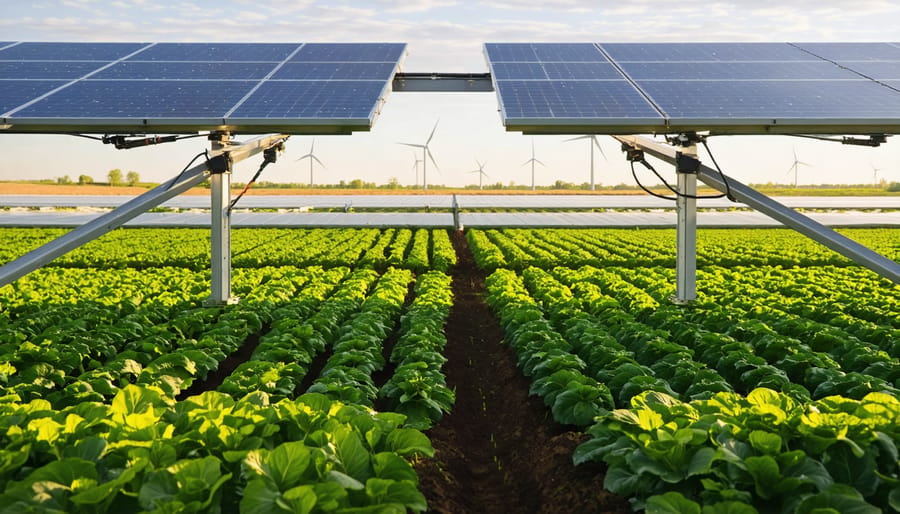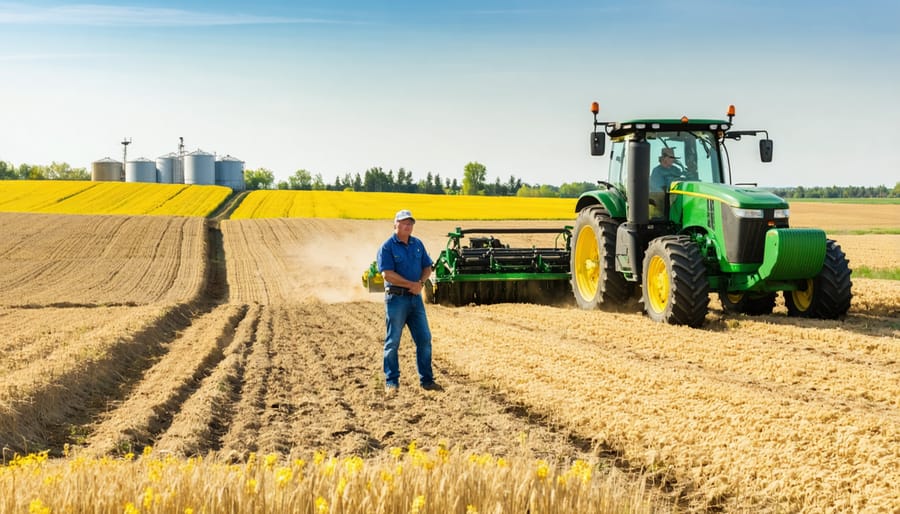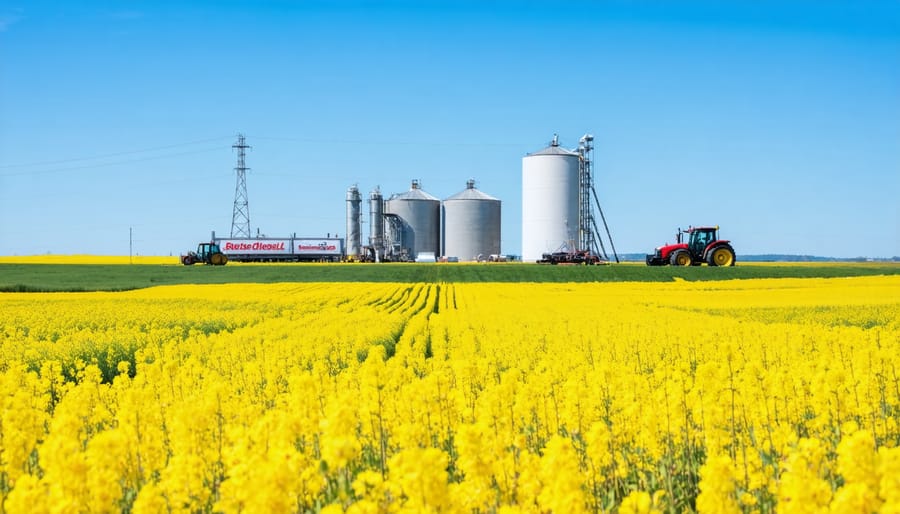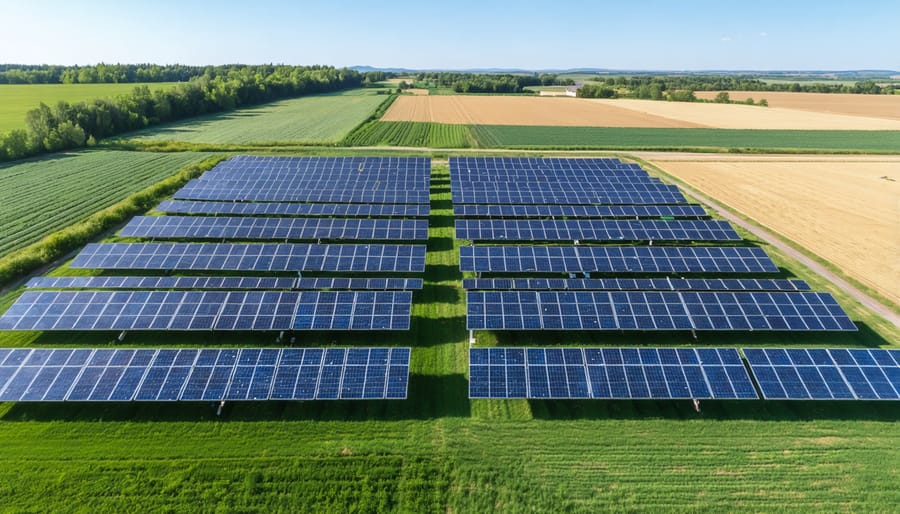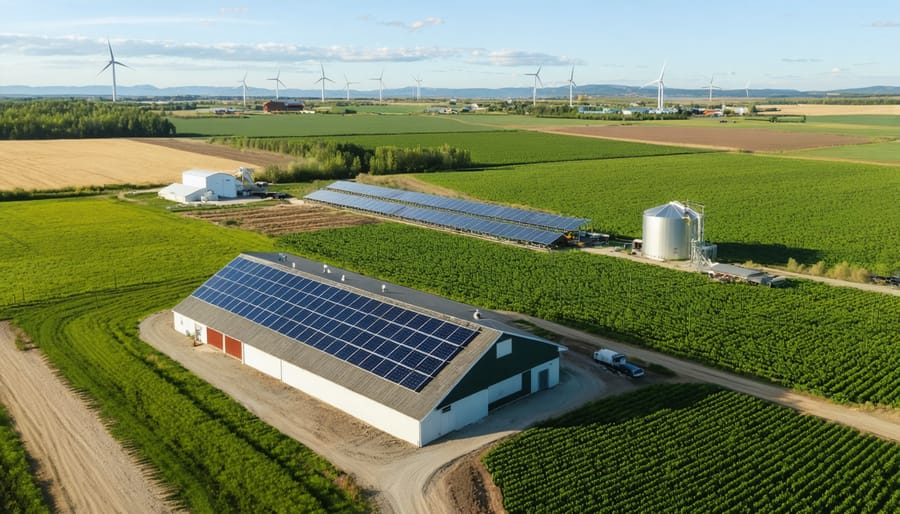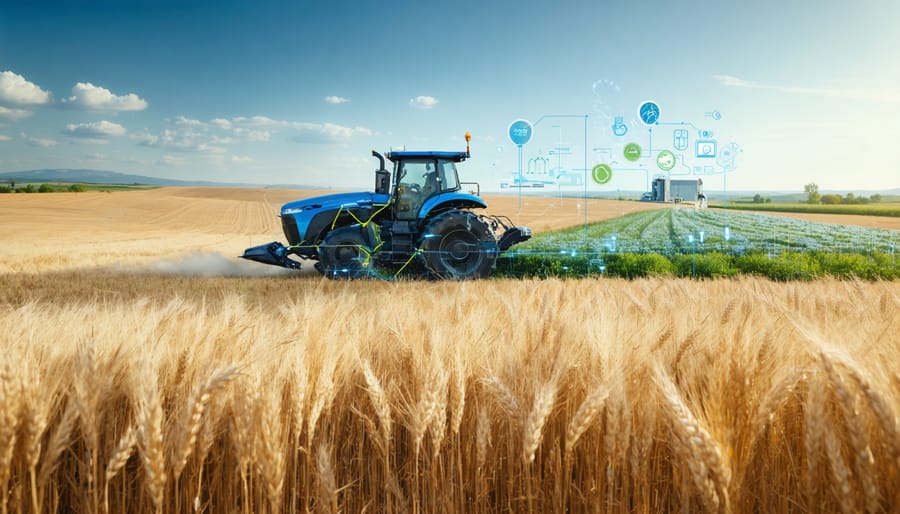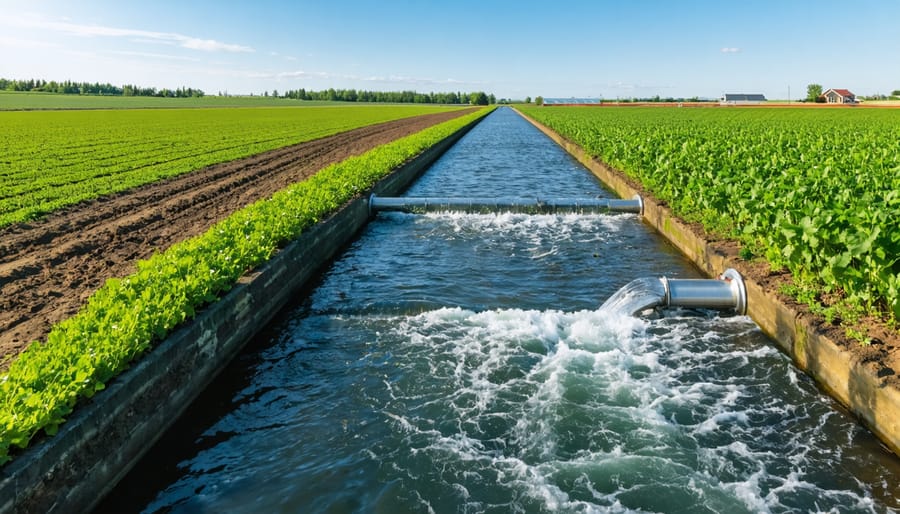Transforming Canadian farms into sustainable powerhouses starts with strategic renewable energy integration – a critical step that’s reshaping Alberta’s agricultural landscape. The benefits of solar power extend far beyond environmental stewardship, offering farmers substantial operational cost savings and energy independence. Recent data shows Alberta farms implementing renewable systems reduce their energy costs by an average of 60% while strengthening their resilience against grid disruptions.
As climate patterns shift and energy costs rise, integrating renewable energy systems isn’t just an environmental choice – it’s a smart business decision. Leading agricultural operations across the province are combining solar installations with innovative storage solutions, creating self-sustaining energy ecosystems that power everything from irrigation systems to cold storage facilities. This integration represents a fundamental shift in how modern farms operate, positioning Canadian agriculture at the forefront of sustainable farming practices.
By embracing renewable energy, Alberta farmers aren’t just reducing their carbon footprint – they’re building more profitable, future-proof operations that serve as models for sustainable agriculture across North America. The technology is proven, the economics make sense, and the time to act is now.
Why Solar Makes Sense for Alberta’s Organic Farms
Alberta’s Solar Advantage
Alberta’s unique geographical position offers some of the best solar potential in Canada, with over 2,300 hours of sunshine annually – more than any other province. Despite our cold winters, Alberta’s solar installations actually perform exceptionally well year-round, with snow reflection often boosting panel efficiency during winter months.
Our clear skies and low humidity contribute to optimal solar conditions, while cooler temperatures help solar panels operate more efficiently than in warmer climates. Even on cloudy days, modern solar technology can generate significant power through diffuse light. Southern Alberta, in particular, receives about 15% more solar energy than Germany, one of the world’s leading solar energy producers.
The combination of long summer days and the reflection from winter snow creates a unique advantage for Alberta farmers. Solar panels typically produce their peak output during summer months when irrigation demands are highest, creating a natural alignment with agricultural needs. During winter, though energy production decreases, the panels continue to generate power, providing a year-round energy solution for farm operations.
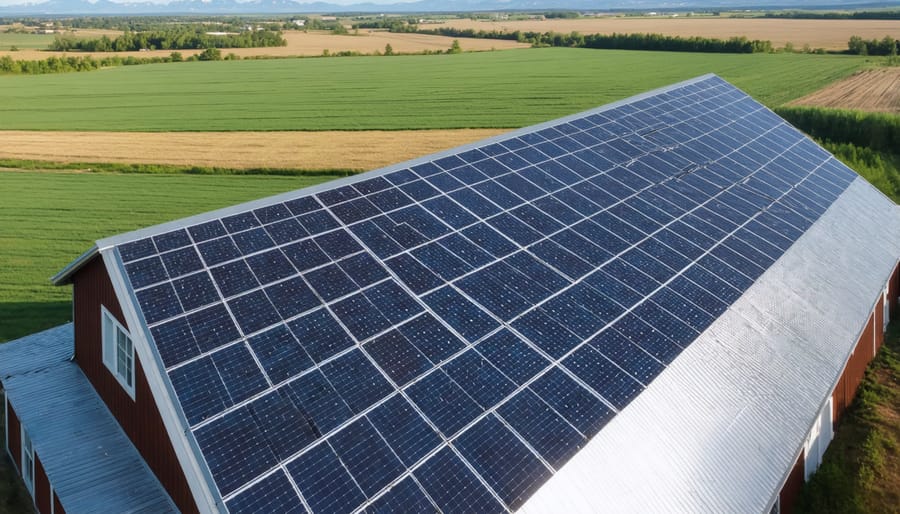
Financial Benefits and Incentives
Canadian farmers can access numerous financial support programs to help offset the costs of renewable energy implementation. The Canada Greener Homes Grant offers up to $5,000 for solar panel installations, while the Agricultural Clean Technology Program provides funding of up to $2 million for larger-scale agricultural clean energy projects.
In Alberta, the Energy Savings for Business Program offers incentives of up to $250,000 for farm businesses implementing energy-efficient technologies. The On-Farm Solar PV Program, when active, covers up to 35% of solar system costs, making the transition more affordable for local farmers.
Additional benefits include accelerated capital cost allowance for renewable energy equipment, allowing farmers to write off investments more quickly for tax purposes. Many rural municipalities also offer property tax incentives for agricultural properties with renewable energy installations.
For financing options, the Canadian Agricultural Loans Act (CALA) program helps farmers secure loans with favorable terms specifically for clean energy projects. Farm Credit Canada also provides specialized renewable energy loans with competitive interest rates and flexible repayment schedules.
Farmers should consult with local agricultural extension offices to learn about current available programs, as incentives are regularly updated and new opportunities emerge.
Real-World Applications on Canadian Organic Farms
Solar-Powered Irrigation Systems
Alberta’s farming community has seen remarkable success with solar irrigation systems, particularly in the southern regions where sunlight is abundant. The Thompson family farm in Lethbridge County serves as a prime example, having reduced their energy costs by 65% since installing their solar-powered irrigation system in 2019.
The system, covering 2.5 hectares of their operation, combines solar panels generating 15 kW of power with smart monitoring technology that optimizes water usage based on soil moisture levels. During peak growing season, the system provides reliable irrigation for their mixed vegetable and grain crops while contributing excess energy back to the grid.
In Medicine Hat, the Prairie Rose Farming Cooperative implemented a community-scale solar irrigation project serving five family farms. Their shared 50 kW system has decreased water consumption by 30% through precise timing and distribution, while eliminating nearly all energy-related irrigation costs.
These success stories highlight key factors for implementation: proper system sizing based on water needs, strategic panel placement for maximum sun exposure, and integration with existing irrigation infrastructure. Local solar contractors familiar with agricultural applications report installation costs typically ranging from $20,000 to $45,000, with most systems paying for themselves within 5-7 years through reduced operating costs and available government incentives.
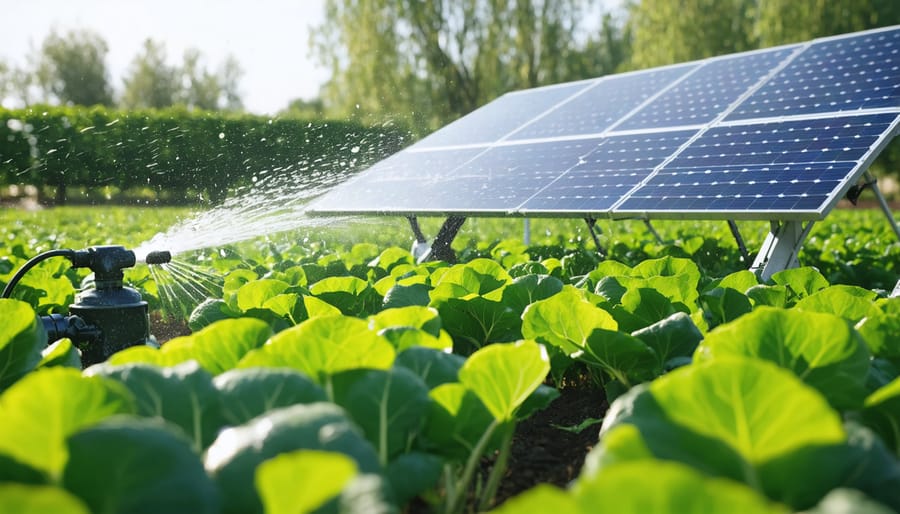
Greenhouse Climate Control
For year-round greenhouse operations in Alberta’s challenging climate, innovative greenhouse energy solutions are essential for maintaining optimal growing conditions while managing costs. Solar energy systems have emerged as a practical solution, offering both environmental and economic benefits for greenhouse operators.
Modern solar installations can power critical climate control systems, including ventilation fans, heating elements, and automated shade systems. By implementing a combination of photovoltaic panels and solar thermal collectors, farmers can maintain consistent temperatures throughout the year while significantly reducing their reliance on traditional energy sources.
Many Alberta greenhouse operators have found success with hybrid systems that integrate solar power with existing infrastructure. These setups typically include energy storage solutions to ensure continuous operation during cloudy periods and overnight hours. For example, the Thompson Family Greenhouse in Lacombe reduced their energy costs by 40% after installing a solar-powered climate control system with thermal storage capabilities.
Temperature management becomes more efficient with solar-powered smart controls that automatically adjust ventilation and heating based on real-time conditions. This precision control not only optimizes plant growth but also maximizes energy efficiency. Local agricultural extension services offer guidance on sizing and implementing these systems based on specific greenhouse dimensions and crop requirements.
Cold Storage and Processing
Cold storage facilities and post-harvest processing are among the most energy-intensive aspects of farming operations. By integrating renewable energy solutions, Alberta farmers can significantly reduce operational costs while maintaining optimal storage conditions for their produce.
Solar-powered cooling systems have proven particularly effective for cold storage facilities. These systems use solar thermal collectors or photovoltaic panels to power cooling equipment, with many farmers reporting energy savings of 40-60% compared to conventional systems. For example, the Morrison Family Farm near Lacombe successfully implemented a solar-powered cold storage facility for their root vegetables, maintaining consistent temperatures between 2-4°C while reducing their energy bills by half.
Innovative thermal energy storage solutions are also gaining traction. Phase change materials (PCMs) can store cooling energy during peak solar production hours and release it when needed, providing reliable temperature control even during cloudy periods. This technology is especially valuable for maintaining stable conditions in grain storage facilities and dairy cooling systems.
For processing operations, timing activities to coincide with peak solar production can maximize energy efficiency. Many Alberta farmers now schedule energy-intensive tasks like grain drying and milk cooling during daylight hours when their solar systems are operating at maximum capacity.
Battery storage systems, while requiring initial investment, can extend the benefits of renewable energy into evening hours, ensuring consistent power for critical storage and processing equipment.
Implementation Steps for Your Farm
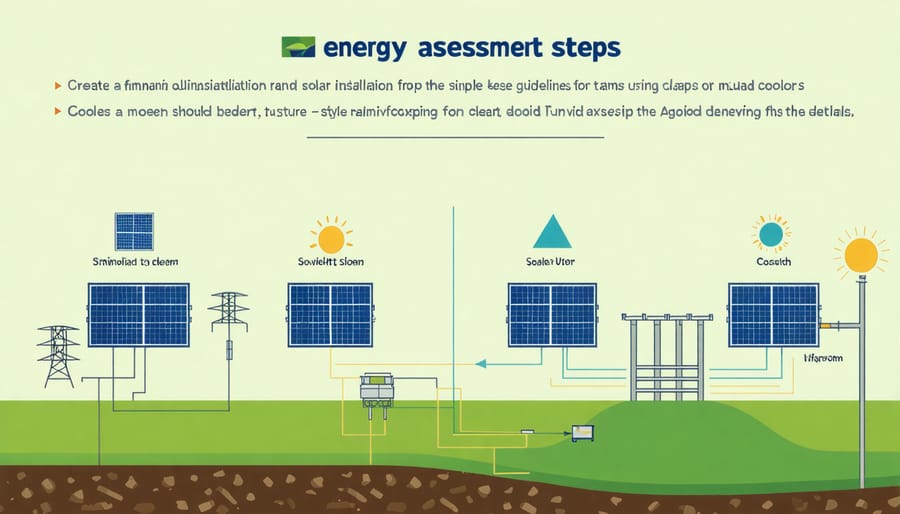
Assessment and Planning
Before diving into renewable energy solutions, it’s crucial to conduct a thorough assessment of your farm’s current energy consumption and future needs. Start by collecting and analyzing your utility bills from the past 12-24 months to establish your baseline energy usage patterns. Pay particular attention to seasonal variations, as these can significantly impact your energy requirements.
Consider working with a qualified energy auditor who understands agricultural operations. They can help identify areas of high energy consumption and potential inefficiencies in your current systems. Many regional agricultural organizations offer subsidized energy audits for farmers, making this professional assessment more accessible.
When evaluating your farm’s renewable energy potential, examine your property’s natural assets. For solar energy, assess your available roof space or ground area with southern exposure. Alberta’s position offers excellent solar potential, as demonstrated by numerous successful solar implementations across the province.
Create a detailed inventory of your energy-intensive operations, including irrigation systems, grain drying, greenhouse heating, and cold storage. This helps prioritize where renewable energy solutions might have the most significant impact. Remember to factor in your farm’s growth plans for the next 5-10 years.
Don’t forget to research available grants and incentives. The Canadian Agricultural Partnership and various provincial programs offer financial support for renewable energy projects. Many farmers find it helpful to develop a phased implementation plan, starting with smaller projects and expanding based on results and available resources.
Finally, connect with neighbouring farms that have already integrated renewable energy systems. Their experiences can provide valuable insights into local challenges and opportunities specific to your region.
Finding the Right Partners
Finding the right partners for your renewable energy project is crucial for long-term success. In Alberta, several qualified professionals can help you navigate the installation and maintenance of renewable energy systems on your farm.
Start by looking for installers certified by the Solar Energy Society of Alberta (SESA) or the Canadian Renewable Energy Association (CanREA). These organizations maintain strict standards for their members, ensuring quality workmanship and professional conduct. Consider reaching out to local agricultural associations and neighboring farms that have already implemented renewable energy systems for recommendations.
When evaluating potential partners, look for companies with specific experience in agricultural installations. They should understand the unique needs of farm operations, including peak energy usage periods during harvest and specialized equipment requirements. Ask for references from other farms they’ve worked with and visit these installations if possible.
Key qualifications to verify include:
– Valid Alberta contractor licenses
– Liability insurance coverage
– Safety Codes Council certification
– Experience with agricultural installations
– Knowledge of local utility requirements
– Understanding of available grants and incentives
Don’t hesitate to interview multiple contractors and consultants. Request detailed proposals that outline project timelines, costs, and expected energy production. A reliable partner should be willing to explain technical aspects in clear terms and help you understand the maintenance requirements of your system.
Remember that the cheapest option isn’t always the best value. Focus on finding partners who demonstrate commitment to ongoing support and have a proven track record in the agricultural sector. Local companies often provide better after-installation service and can respond more quickly to maintenance needs.
Maintaining Your Solar Investment
A well-maintained solar system can deliver reliable power for 25+ years, making it a sound long-term investment for your farm. Regular maintenance isn’t complicated, but it’s essential for optimal performance and longevity.
Start with monthly visual inspections of your solar panels, especially after storms or heavy snowfall. In Alberta’s climate, snow removal is crucial – while panels are typically installed at an angle that promotes natural snow sliding, you may need to carefully clear heavy accumulation using a soft-bristled brush with an extended handle.
Keep panels clean from dust, bird droppings, and agricultural debris. Most installations benefit from a thorough cleaning twice a year, ideally in spring and fall. Use plain water and a gentle brush – avoid harsh chemicals that might damage the panel surface. Many Alberta farmers schedule panel cleaning alongside regular equipment maintenance routines.
Monitor your system’s performance through your inverter display or monitoring app. A sudden drop in energy production could indicate an issue requiring attention. Document your system’s typical output levels throughout the year to help identify any concerning variations.
Vegetation management is particularly important for ground-mounted systems common on farms. Maintain clear space around your panels to prevent shading and ensure good airflow, which helps maintain optimal operating temperatures.
Have a qualified technician inspect your system annually. They’ll check electrical connections, inspect mounting hardware, and verify inverter performance. Many local solar installers offer maintenance packages specifically designed for agricultural installations.
Consider installing a backup power system or energy storage solution to maintain critical operations during grid outages. This adds another layer of maintenance requirements but provides valuable operational security.
For Alberta farmers, joining local renewable energy groups can provide valuable maintenance tips and shared experiences. Many successful solar farmers in our region have developed efficient maintenance routines that balance system care with busy agricultural schedules.
Remember to keep detailed maintenance records – these are valuable for warranty claims and can help identify seasonal patterns in system performance.
Integrating renewable energy into your farm operations represents a significant step toward sustainable agriculture and long-term financial stability. Throughout Alberta, farmers are discovering that renewable energy systems, particularly solar installations, can dramatically reduce operational costs while supporting environmental stewardship. By starting with an energy audit and working with local renewable energy experts, you can develop a tailored plan that fits your farm’s unique needs and budget.
Remember that government incentives and funding programs are available to help offset initial costs. Connect with your local agricultural extension office or renewable energy associations to stay informed about new opportunities and technological developments. As our farming community continues to embrace sustainable practices, sharing experiences and learning from fellow farmers who have already made the transition can provide valuable insights for your own renewable energy journey.
Take the first step today by assessing your energy needs and exploring available options. Your farm’s sustainable future starts with renewable energy.

